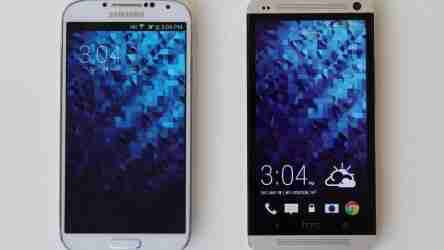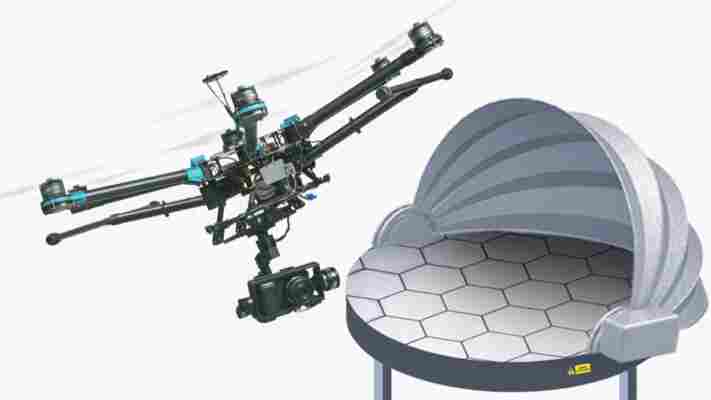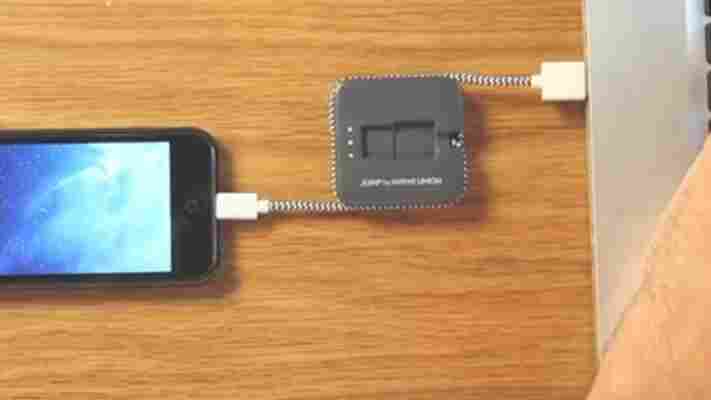Lots of people expected more from Apple’s announcement yesterday . If you’re not excited by the new iPhone 5c and iPhone 5s , and the prospect of upgrading to iOS 7 leaves you cold , we’ve got you covered.

Change is hard, so if you’re considering jumping ship to Android, here’s your ultimate guide to the best Android handsets on the market right now .
Android is better than ever before and we think that it’s a great alternative if you’re looking to switch away from iOS. Applications for Android are beginning to be released at the same time as iOS and many of them are able to do things that you couldn’t ever dream of doing on an Apple device.
Here’s the state of the market right now and what to expect in the near future.
If you’ve never used an Android device before, you’re probably in for a shock, unlike in the Apple world you’re able to customize or change anything you please. From setting up NFC stickers around your home to automatically changing settings on your phone depending on the room you’re in, triggering events to happen when conditions change around you, to installing a better keyboard , or even replacing the entire look and feel of the OS . It’s all possible and the opportunities are endless.
Android has come a long way from the ugly, fragmented mess it was in the past, and devices are receiving updates somewhat consistently these days. To get an in-depth look at just how great Android is, we recommend reading Paul Stamatiou’s post entitled “ Android is better .” You’ll likely come away enthused about switching if you were already considering making the jump.
There are a bunch of terms you’ll hear in the Android world that aren’t really applicable anywhere else, so it’s worth going over what they mean and what services you might have questions about as you switch across:
Stock ROM vs OEM ROM vs Custom ROM
A stock ROM is a ‘clean’ version of Android from Google without any skins or extra apps installed. It sports the “holo UI”, which is the default Android look and feel and does not include any carrier or manufacturer specific modifications. These images are also more likely to get updates as they’re provided directly with updates by Google.
An OEM ROM is a customized version of Android that usually comes with a skin created by the manufacturer that changes the look of the entire OS, including many of the bundled applications. A few examples of these are Samsung’s Touchwiz and HTC’s Sense UI. Handsets running these ROMs may receive one or two major Android version bumps but are unlikely to see future versions after a year or two as the manufacturer controls the update process.
Generally speaking, most users prefer the default Android experience but almost all phones ship with carrier customizations. There are many third party projects that seek to fix this by releasing their own stock versions of Android for phones that come with custom skins, such as the Cyanogenmod project.
Does it have a Photo Stream type feature?
Not built into the OS, but many applications such as Dropbox and Google+ offer the exact same functionality, but better (since they don’t stop you from having more than 1,000 photos in your stream). Since applications are able to easily run in the background on Android, they can be backed up in real time.
Is there some sort of music store on Android?
Yes! Google’s Google Play Music is a combined Spotify competitor and music locker where you can buy and stream music directly on your Android phone. It’s similar to the new iTunes Radio service in iOS 7, but you can store the music you already own in it too and synchronize it offline with your device.
How do I get music onto an Android device?
There’s no iTunes-esque official media synchronization tool for Android but it’s a lot more simple. You can mount the phone as a USB drive on your computer and simply copy the media across to your device, regardless of format. Otherwise, there are third party solutions that act as iTunes replacements for getting content on your device if you prefer to do it that way.
Is there some sort of iCloud service for backups? How about email or calendar?
Yes and no. There is an Android backup service, but it’s not very good. It restores your apps and some of your data from the Play Store when you log in to a device but I’ve found it to be very hit and miss. That said, you can do full device backups with services such as Carbonite for Android , which essentially does the same thing as iCloud.
As for email and calendar, I’d suggest switching from iCloud to Gmail for Android. It is the best experience hands-down and the Gmail/Calendar applications are extremely powerful compared to anything else out there. You can export all your contacts and import them into Google Contacts easily enough too. We can’t recommend it enough.
What are the different versions of Android and what do they mean?
There’s a ton of versions of Android, but we’ll go over the latest briefly to help you understand since there are so many codenames:
Android 4.0: Ice Cream Sandwich
Android 4.1: Jellybean
Android 4.2: Jellybean (Incremental Update)
Android 4.3: Jellybean (Incremental Update and the latest version of Android )
Android 4.4: KitKat (The future release of Android)
If you don’t mind a bit of plastic, the Samsung Galaxy S4 is the best all-round Android phone. It’s got a fantastic camera that rivals that of the iPhone, is the fastest device for the price and still holds the most popular Android handset spot.
The S4 features an Octa-core (yes, eight cores) 1.6 GHz Cortex-A15 & quad-core 1.2 GHz Cortex-A7 for low power usage. It’s extremely powerful and doesn’t miss a beat, no matter what you throw at it and battery life is impressive for an Android device, sometimes reaching two days on a single charge.
Sporting a 5-inch 1920 x 1080p display, the colors pop and it doesn’t disappoint. As with the HTC One, the size of the screen is amazing and really makes content shine. It’s hard to go back to anything smaller — despite whatever reservations you might have about going to a larger phone at first — we’d be surprised if you didn’t come to love it quickly.
Unlike the One, if you’re a big phone photographer, the S4 won’t disappoint at all compared to the iPhone. It consistently puts out impressive shots — just like the iPhone — that are full of color and detail, ready to Instagram.
The non-Google edition of the S4 comes with Touchwiz, which is inconsistent and generally ugly. We wouldn’t recommend it to most people since the stock experience is so fantastic.
When we put the One and S4 against each other head to head , our verdict was that, when a Google Edition of a phone was available, it would be the handset to buy in 2013. You’re now able to get it. It’s the perfect Android device and we’d hesitate to recommend anything else.
The stock experience on such a great device is fantastic and we’d recommend that if the plastic hardware doesn’t bother you so much then you should make this your first Android device.
That said, if you live in a country where you can’t get the Google Edition S4, the official S4 with Touchwiz is still an incredible device. It’s packed to the brim with a plethora of features and useful applications such as health monitors and features like the ability to keep the screen on while you’re still looking at it. Don’t let the unavailability of the Google Edition put you off, it’s always possible to load a custom ROM of Android.
You can purchase the Google Edition of the S4 from Google Play directly , if we’ve already convinced you. Unfortunately, the Google Edition is US-only, so if you’re elsewhere you should still get the official S4, it’s still a fantastic phone.
This is possibly the most stunning and Apple-esque device to date. We did a full review of the One up against the S4 a few months back and loved the hardware, saying that “this is the first time a handset manufacturer has managed to get it just right on an Android phone” and it still holds true. Nobody else has come close and we’d be hard-pressed to recommend much more to anyone else.
The display on the One is a whopping 4.7 inches in size with a 1920 x 1080 resolution, which is the most beautiful display on an Android device and once you’ve used a phone with so much screen real estate, you’ll find it hard to go back to the iPhone. It’s big in your hand at first but is easy enough to get used to.
Audio on the One is probably the best you can get on a mobile device too, with the phone having two forward-facing speakers. They’re crisp and bassy, something you wouldn’t generally expect from a phone. If you’re the type to listen to music on the beach or around the house on your phone, it’s absolutely worth it.
The sad part about the One is that the camera is lackluster. HTC brags that it features a new type of sensor called “Ultrapixel”, but it’s ultimately a bit disappointing . The photos it produces are dull and uninteresting most of the time, unlike that of the iPhone, but they might be good enough for most people.
With the One, there are two options which are very different. There’s the official HTC edition, which comes loaded with Sense UI and a plethora of camera enhancements/extra features that really do add to the experience. Sense UI is better than it’s ever been, but we weren’t big fans of it when we reviewed it.
Luckily, there is a Google Edition of the device which comes with stock Android and without the HTC cruft, but sadly that means you won’t get the camera enhancements like Zoe mode. If you live outside of the US and can’t get the Google Edition device, Sense UI does have a handful legitimately useful features such as the ‘ blink feed ‘, which is very similar to Windows Phone’s live tiles and allows you to get updates from social media/news rapidly on your home screen as well as the many awesome camera enhancements, like a mode that lets you remove objects and people from a photo if it didn’t come out right.
If you’re interested in getting the Google Edition HTC One, you can pick it up from Google Play directly . If you’re in Europe or elsewhere, you’re out of luck unfortunately, but we’d say that picking up the normal HTC One would be the next best thing.
Google’s first foray into directly building Android smartphones with Motorola at the helm has been an interesting one. If you’re looking for a unique phone for a reasonable price, the Moto X is probably for you.
Unlike most other Android phones, the flagship features of the Moto X are the ability to customize the handset to your heart’s desire and the hands-free controls, which aren’t available anywhere else. Oh, and it’s the only phone on this list that’s actually assembled in America.
The customization feature of the Moto X is quite amazing, you’re able to visit a tool called the Moto Maker and choose the color of your phone, the color of the trim, customize the boot screen with your name and details and more. In the future, you’ll be able to get a wooden-backed version of the phone, too, if you’re into that 70s look.
Voice is central to the Moto X, with many of the features you’ve probably seen on Google Glass. You’re able to wake the phone up and instruct it to do tasks by simply saying “OK, Google Now” and operate the phone without touching it at all. It also has a features like the ability to detect when you’re driving a car and will automatically respond to incoming texts to tell them that you’re driving.
As for specifications, it’s not the best Android phone but it’s far from the worst. Sporting a 4.7-inch 720p display, reviews suggest that whilst it’s not the best screen on the market, it’s pretty damn good.
Unfortunately, the camera isn’t very good. It’s hit and miss, despite being a ten megapixel shooter, it often takes lackluster photos that are blurry and generally disappointing. The camera application is so basic that you can’t even focus before you take a photo and there aren’t many settings to change outside of enabling and disabling the flash. If you’re a big photo taker, especially coming from an iPhone, this one probably isn’t for you.
That said, the Moto X is probably the best-priced and the most unique phone on the market. The voice features are attractive and offer a new way to use the phone, so if you’re really interested in trying something new, it’s a fantastic phone. Of course, because the Moto X is built by a Google-owned company, you get an essentially pure experience, with little bloat and few carrier-added apps out of the box.
To get your hands on the Moto X, head over to the Motorola website to check the best way to purchase it. The Moto X is only available in North America and parts of Latin America.
If you’re on a budget, the Nexus 4 is the best phone you can get for your money following the recent slashing of prices by $100.
Undoubtedly, you’ve at least heard of the Nexus 4; before the HTC One was released it was the most beautiful handset to ever grace Android. The gorgeous glass back and subtle “disco light” finish underneath the glass reminded everyone of the iPhone and for good reason, it’s beautiful!
The Nexus 4 is last year’s flagship Google phone, and, until the Google Edition S4 and One were released, was the best pure Android device you could buy. If you’re not familiar with the Nexus program, Google works directly with a handset manufacturer each year to produce a “pure” Android phone aimed at developers and then sells it directly.
The Nexus 4 features a 1.5GHz Snapdragon processor, a 4.7-inch screen with 1280 x 720 resolution and the lowest price you’ll find for such a high-end smartphone. It’s just $249 for the 16GB model , which is awesome despite the fact that the phone has been on the market for a while.
Even the camera is pretty fantastic, with Engadget rating it pretty well compared to the benchmark Android phone at the time — the S3 — when they reviewed it in late 2012. Unfortunately, good stories always seem to have some sort of downside, though, such as the lack of LTE on the device. That said, it may not be a deal breaker for many people since 3G is often more than enough.
If you’re considering the Nexus 4, just know that it’s very likely Google will announce the Nexus 5 in the near future thanks to a recent leak in the Android KitKat launch video and a subsequent FCC filing . If you’re not the type to get phone envy, though, the Nexus 4 is a safe bet and is a fantastic Android experience for the price.
As you can see, there are some fantastic Android handsets on the market and they’re more than capable of replacing an iPhone these days. Android has come a long way from the old days where it was messy, slow and heavy on battery. It’s now much more elegant and can finally compete against a platform like iOS.
There are hundreds of different handsets made by many different companies, so this is just a sampling of the devices we believe are the best on the market right now . There is so much choice out there that it can be sometimes hard to decide, but the devices above are truly best in class.
There’s never been a better time to consider switching to Android.
Now read: What the iPhone 5s ’64-bit’ processor means, in plain English.
This company is bringing military-style drone tech to the rest of us
While we normal folk can operate drones merely within direct line-of-sight, the military can control a UAV (unmanned aerial vehicle) over Afghanistan from the other side of the world. Now, French company UAVIA is bringing that more advanced approach to the civilian world.

With UAVIA’s technology, users can operate a drone remotely via the Web. The vehicle is given its instructions via a 4G internet connection that also sends back an HD video feed from the onboard camera. If the signal cuts out the drone can either continue its pre-planned flight or make a safe landing automatically.
Given the strict regulations around civilian drone usage, UAVIA is currently restricting its market to the industrial sector in France, where ‘beyond line of sight’ control is allowed in certain circumstances. It says the system is already being used by companies, but it isn’t saying exactly who.


UAVIA’s tech allows companies to do safety and security inspections of remote facilities while the inspector sits in head office. It’s an approach that can save a lot of time time and money versus traveling to the location and doing the work in a helicopter.
While regulations limit UAVIA for now, the firm sees potential use cases in agriculture, disaster relief, search-and-rescue operations, and wildlife protection.
UAVIA’s CEO Clément Christomanos is optimistic that a European regulatory framework will be in place by the end of 2016, and could encourage more drone makers to include internet connections on their vehicles. “The use of intelligence and internet on drones like we do should dramatically simplify safety management as it would become simple to report flight information to the air traffic authorities.”
“Our goal is to demonstrate that our solution is safe and does not pose any hazards,” Christomanos continues. “For our first customers, we fly in a strictly confined area and not over ‘public’ airspace to guarantee a safe and legal operation.
“All these experimentations will allow us to collect proof that such drone operations can be safely done, and by demonstrating these results we will slowly make the regulatory frame evolve towards more autonomous drone applications.”
UAVIA has partnered with Ubuntu for the technology behind its product. Its drones run the Ubuntu Core operating system , designed for embedded devices.
The company started up two and half years ago with €16,000 ($17,500) of its own money, and has bolstered that with interest-free innovation loans backed by the French government. It is now raising a €500,000 private investment round which it hopes to close in the first quarter of 2016.
It may still be quite some time before we normal folk can fly drones over distant lands from the comfort of our homes, but UAVIA gives us a glimpse of that future.
Native Union crowdfunds JUMP, a cable and portable battery that charges itself after your smartphone
Keeping the batteries in your smartphone and tablet topped up throughout the day can be tough. Instead of strapping on a bulky case or carrying an external power brick the size of a small tank, Native Union is offering a smart, pocket-sized charging cable and portable battery called JUMP on Kickstarter.

It’s smaller than a hockey puck (50mm x 50mm x 13.6mm) and the two reinforced cables wrap around its exterior to keep it clean and mess-free. An 800mAh battery is hidden inside, which is roughly a third of the power pack found in the iPhone 5 and 5s. While it won’t bring your device back to 100% charge from flat, it should still prove yourself for those who find themselves in the red during the latter part of the day.
The JUMP’s pièce de résistance is its ability to automatically recharge its own internal battery once it has finished reviving your smartphone. So if you’re charging from a wall socket or your laptop, JUMP will detect when the battery is full and begin charging itself unprompted. This means, at least in theory, that the JUMP should have 100% charge more often, and therefore more useful out in the wild.
Native Union smashed its $40,000 funding target in a little over 24 hours, but you can still pre-order the device by pledging $40 or more before the campaign ends on February 13, 2014. It’s available with a Lightning Connector or MicroUSB and is expected to ship in May.
➤ JUMP (Kickstarter)
